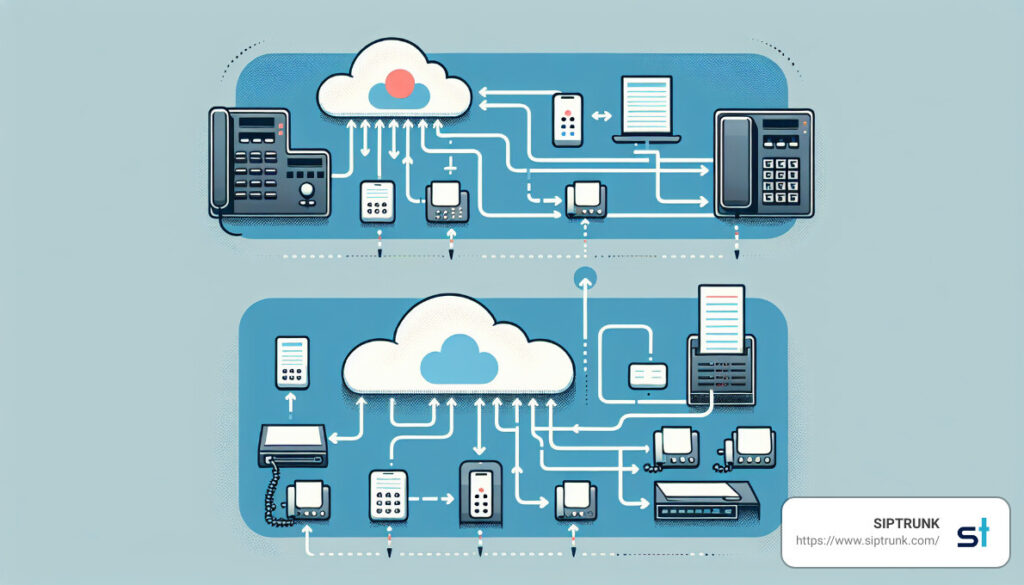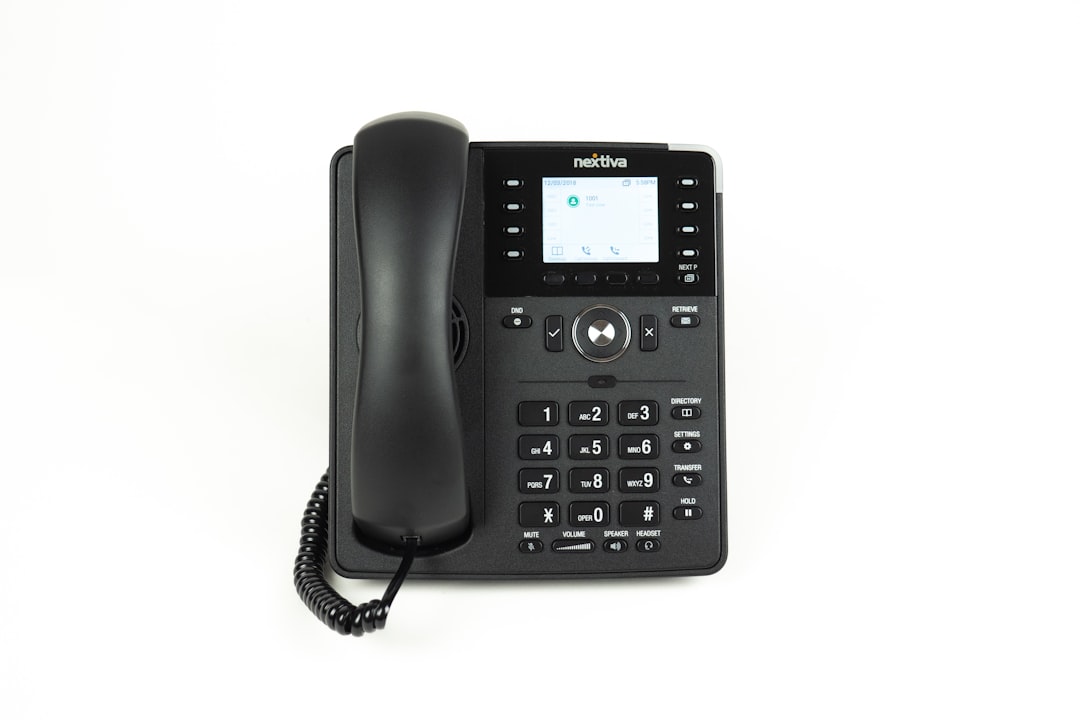
A Comprehensive Guide to Hosted VoIP vs. SIP Trunking Differences
Introduction
Have you ever found yourself tangled in the web of telecom jargon, asking “What’s the real difference between Hosted VoIP and SIP Trunking?” As telecommunication advances at a lightning pace, understanding these terms can be crucial for growing businesses like telecom agents, dealers, and IT consultants amongst others seeking to deliver top-notch services.
Brief Overview of VoIP and SIP Trunking
Hosted VoIP and SIP Trunking both serve as platforms to deliver telephone services and multimedia sessions over the internet. They’re parts of the Voice-over-IP (VoIP) phone system landscape but serve distinct roles.
-
Hosted VoIP is an external service provided by a vendor which removes the need for businesses to own or maintain on-site equipment. It’s a complete telephony system deployed and maintained by third-party providers.
-
SIP Trunking, on the other hand, is a protocol used within VoIP network to set up real-time sessions of audio and video communications. It is used by businesses that have their own PBX and want to connect it to the internet-based telephone system.
Importance of Understanding the Differences
Understanding these differences plays a critical role in driving informed decisions for your telecommunication needs, shaping your customer offering, and ultimately, your business growth.
Knowing the differences between these two telecom giants, why it matters and how it impacts your business costs, flexibility, scalability, and the overall service delivery to your customers is an absolute must. So, let’s take a deep dive into Hosted VoIP and SIP Trunking—assimilating their capabilities, strengths, and their varying nuances.
Fasten your seatbelts as we embark on this enlightening journey of telecom exploration!
Understanding VoIP and SIP: Definitions and Functions
To fully comprehend the differences when comparing hosted VoIP vs SIP trunking, it’s crucial to understand their definitions and how they function.
What is VoIP?
Voice over Internet Protocol, commonly known as VoIP, is a technological family that facilitates the transmission of voice calls over the internet. VoIP transforms analog voice signals into digital packets and sends them over the internet, allowing you to make calls from a computer, a VoIP phone, or other data-driven devices.
The cornerstone of VoIP’s appeal lies in its cost-effectiveness, ease of installation, and flexibility. It eliminates the need for traditional phone lines and long-term contracts while providing the freedom to make calls from anywhere with an internet connection. However, it’s important to remember that VoIP, on its own, primarily supports voice communications and may lack integration with third-party apps or software.
What is SIP Trunking?
On the other hand, Session Initiation Protocol (SIP) trunking is essentially a virtual version of an analog phone line. It facilitates the sending and receiving of various data types, including voice, video, and messaging, over the internet. To put it simply, a SIP trunk is a direct connection between your organization and an Internet Telephony Service Provider (ITSP).
A key aspect of SIP trunking, as explained in SIP Trunking Basics, is that it contains multiple channels, each capable of handling a single phone call. When a call is made, a session is initiated, occupying one channel. This way, you can have multiple calls happening concurrently over the same trunk—each utilizing a different channel.
By leveraging SIP trunking, you can significantly reduce your business’s infrastructure requirements. It enables the addition of multiple channels to a single SIP trunk, allowing for multiple phone lines. This is a game-changer for growing businesses, eliminating the need to pay for individual lines each time a new employee is hired.
How VoIP and SIP Trunking Work Together
While VoIP and SIP may seem similar, they play quite distinct roles in the realm of internet telephony. VoIP is a broad term that encompasses various protocols, including SIP, for voice communications over the internet. Essentially, VoIP is the car, and SIP is the highway that allows the car to reach its destination.
SIP is a protocol that describes how VoIP calls are established, maintained, and terminated. In other words, it is a subprotocol that enables VoIP. By integrating SIP capabilities into your VoIP system, you can significantly enhance your communication solution—adding video, messaging, and other multimedia communications to your existing voice-only system.
At SIPTRUNK, we provide a robust and easy-to-use platform that allows you to seamlessly integrate SIP trunking with your VoIP services—creating a scalable, customized communication solution that effectively caters to your business’s needs.
The Role of SIP in VoIP
As we delve deeper into modern telecommunications, grasp the crucial role that SIP plays in VoIP. This involves understanding SIP as a protocol in VoIP, how it enhances VoIP functionality, and the concept of SIP trunking in VoIP.
SIP as a Protocol in VoIP
Session Initiation Protocol, better known as SIP, is a standard protocol used for initiating, maintaining, modifying, and terminating real-time sessions that involve video, voice, messaging, and other communications applications. Within the context of VoIP, SIP serves as a set of rules that govern how VoIP calls are established, managed, and disconnected.
In simpler terms, SIP is like a traffic controller, managing the flow of voice and multimedia traffic over the internet. It ensures that your VoIP calls connect to the right destination and disconnects them when the conversation ends, making it a pivotal component of any VoIP system.
How SIP Enhances VoIP Functionality
While VoIP alone is an excellent technology for transmitting voice calls over the internet, SIP enhances this functionality by adding support for multimedia communications. This means that with SIP, your VoIP system can handle not only voice calls but also video calls, messaging, and even fax communications.
This multimedia support is particularly beneficial in today’s business environment where communication needs are becoming increasingly diverse. From video conferencing and team collaboration to customer service and marketing outreach, SIP brings a level of versatility to your VoIP system that can significantly boost your business’s communication capabilities.
Moreover, as a scalable solution, SIP allows you to easily add or remove channels based on your business needs, making it a cost-effective solution for growing businesses.
The Concept of SIP Trunking in VoIP
SIP trunking is an essential concept in VoIP that refers to the virtual version of an analog phone line. A SIP trunk acts as a virtual connection between an organization’s PBX and the internet, enabling the organization to place VoIP calls. Each SIP trunk can support multiple SIP channels, with each channel being able to handle one incoming or outgoing call.
In a sense, SIP trunking is like having multiple phone lines, but without the need for physical connections. This not only reduces infrastructure costs but also simplifies the scaling process. With SIP trunking, you can add many channels to a single SIP trunk as your business grows, eliminating the need to pay for individual lines each time you hire a new employee.
In conclusion, the role of SIP in VoIP is integral, enhancing VoIP functionality, enabling multimedia communications, and providing a scalable, cost-effective solution for businesses. As your business expands and evolves, so can your VoIP system, thanks to the flexibility and scalability offered by SIP and SIP trunking.
At SIPTRUNK, we’re committed to providing you with superior SIP trunking services that empower your business communications. Whether you’re looking to expand your communication capabilities or seeking a reliable SIP trunking provider, we’ve got you covered.
The Benefits of SIP Trunking for Resellers
The world of telecommunication presents numerous opportunities for growth, especially for those willing to adapt to the evolving landscape. One such lucrative area is the reselling of SIP trunking services. In this section, we’ll delve into how SIP trunking can increase revenue for resellers, the advantages of white-labeling SIP trunking solutions, and how we at SIPTRUNK can empower you on this journey.
How SIP Trunking Can Increase Revenue for Resellers
Reselling SIP trunks can be a highly profitable venture due to multiple reasons. First, SIP trunks are in demand by businesses of all sizes due to their cost-effectiveness, scalability, and ability to support a variety of communication channels such as voice, video, messaging, and fax.
Also, SIP trunking enables businesses to save up to 40% on local calling and up to 90% on international calls, making it an attractive option for businesses looking to cut communication costs.
In addition, as a reseller, you can offer value-added services like call routing, call recording, and unified communications, which not only enhance your clients’ communication capabilities but also provide you with additional revenue streams.
The Advantages of White-Labeling SIP Trunking Solutions
White-labeling is a business model that allows you to rebrand products or services as your own. This approach has several advantages when applied to SIP trunking solutions.
Firstly, white-labeling allows you to build your brand and reputation in the market. Instead of selling services under another company’s name, you can offer SIP trunking under your own brand, bolstering your image as a comprehensive solution provider.
Secondly, you can enjoy increased revenue without the trouble of managing the technology. Your SIP trunk provider, such as SIPTRUNK, handles the equipment and support, allowing you to focus on marketing and selling your services.
Lastly, white-labeling enables you to offer a broader range of services, thereby attracting more customers and increasing your market share.
The Role of SIPTRUNK in Empowering Resellers
Here at SIPTRUNK, we’re committed to supporting telecom agents, dealers, VARs, manufacturers, distributors, master agents, and IT consultants looking to expand their business and offer SIP trunking services to their customers.
We offer a reliable, easy-to-use platform that allows you to resell SIP trunks without the hassle of contracts, upfront costs, or hardware. Our service integrates with all major IP PBXs, IP gateways, and open-source PBXs, ensuring maximum compatibility with your clients’ existing systems.
In addition to providing the necessary technology, we also offer top-notch customer service, assisting you with the setup process and any technical issues that might arise.
SIPTRUNK is not just a provider, but a partner dedicated to helping you succeed in the competitive telecom market.
In conclusion, SIP trunking presents a lucrative opportunity for resellers looking to increase their revenue and expand their service offerings. With the right partner, like SIPTRUNK, you can effectively navigate the market and reap the benefits of this robust communication solution.
At SIPTRUNK, we understand the intricacies of both these technologies and are committed to helping you make an informed decision that best suits your business needs. We provide a robust platform that allows resellers to offer SIP trunking services to their customers, empowering them to expand their business and increase their revenue.
